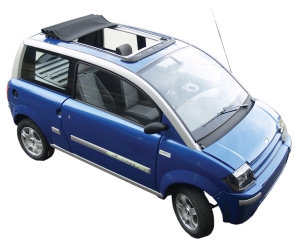I talked to a few people at Discover Brilliant. I’ll be getting Q&As up over the coming weeks.
Bill Williams is the California sales director for Zenn Motor Co., maker of neighborhood electric vehicles (NEVs). In addition to selling one of the most full-featured NEVs, Zenn has an exclusive contract with a tight-lipped and somewhat mysterious company called EEstor. EEstor claims it’s making an ultracapacitor that will so far outperform previous capacitors that it will effectively replace the electrochemical battery in all applications — most notably cars. It could revolutionize the auto industry, and Zenn alone will have rights to put the EEstor energy packs containing the capacitors in small and medium-sized vehicles. That is, if EEstor delivers, which is a subject of much skepticism. Despite possible delays, EEStor still expects to be manufacturing its pack by mid-2008 at the latest.
—–
DR: I heard EEStor has moved back delivery of their capacitor to you guys until 2008. Originally it was going to be by the end of this year. Is that right?
BW: I have heard two different things, so I’m just going to wait and see.
DR: Can you tell me what the two things are?
BW: What you just said. I heard that we would be in production, according to Dr. [CEO Richard] Weir, in about 9 or 10 months. Him delivering the final product that we can test, as far as I know, is still by the end of this year.
DR: What’s the target market for your NEVs?
BW: It’s a wide range. Urban pioneers — the Zenn is perfect for somebody who wants to travel in a short range, in inner-city mode. The fleet application for university campuses, corporate campuses, military bases — they’ve all had their hands slapped and told to increase their number of alternative fuel vehicles. Ironically, there are golf-cart communities that became NEV communities.
 DR: Is anybody using these for a Flexcar-style system?
DR: Is anybody using these for a Flexcar-style system?
BW: We’ve just been talking to Flexcar today.
DR: These things are legal on streets where the speed limit is 35 or under? That’s the law?
BW: Federal law — the federal motor vehicle standard (FMVSS) 500.
DR: But they’re only allowed to travel 25mph?
BW: That’s the top regulated speed. Above 25, NTSA requires safety bags and crash testing. And there is that much difference in crash tests — at 25 there’s a lot less damage than there is at 35. Keep in mind that our ZENN is overkill, in the sense of safety and structure, compared to what’s in the same category: an open-air golf cart. We’ve got a real body around it.
DR: What do you see as the path between here and fully robust, highway-ready electric vehicles?
BW: The price of lithium batteries coming down. The EEstor pack coming to fruition and being produced. I also see, instead of polluting Mother Earth with a bunch of used cars and replacing them with Priuses, converting the car you have. Our contract with EEstor is for any car weight of 1500 kilos or less — about 3,000 pounds. A Corolla, a Camry, a RAV 4. That category leaves us with over 800 million cars.
DR: So you can convert an existing internal combustion car to an EEstor pack?
BW: Yeah, people are doing conversions already — the EEstor pack is just where the energy is going to come from. When EEstor comes out and we can offer a wider range, we’ll look at putting an EEstor pack in a converted car. Or there could be conversion shops that buy the EEstor pack from us and do it. We could be like Intel Inside — instead of building more cars, just changing the guts.
DR: Where would electric cars have to get to blow the market open?
BW: To make the general public happy, it’s gotta be equal to their ICE [internal combustion engine] car now. Even an Expedition or an Explorer will get 350 miles on a tank, so needs to get 350. And it needs to be not too inconvenient to bend over and plug it in. The infrastructure is there. We have an overabundance of electricity right now, especially at night.
DR: What about people at apartments that can’t plug in?
BW: Cities are getting their act together. Santa Monica’s considering plug-ins and they have free parking for electric vehicles. Austin Energy has been putting plug-ins in downtown Austin. It’s a wave, and it’s got to happen from both ends, the consumer demand and the developers realizing, hey, as long as we’re planning this city, let’s put plug ins in. There are solar companies discussing what kind of solar panel it would take to have a little charging station. Ore. Dept. of Transportation is putting solar-powered stations in at some of the rest areas.
DR: Everyone assumes we’re on a path from ICE to hybrid to plug-in hybrid to fully electric. EEstor could jump those categories.
BW: We do hope so. Dr. Weir has been very quiet about his approach to things, and that frustrates people. Honestly, every time Zenn puts out a press release about Eestor, I kind of cringe. People will say, why should should I buy the toaster you’re selling now if the microwave’s coming out next year? And I say, honestly, if you want to make a difference, you can buy the car now. You have to get wet to catch the wave.

